- Home
- Michael Chabon
McSweeney's Mammoth Treasury of Thrilling Tales Page 3
McSweeney's Mammoth Treasury of Thrilling Tales Read online
Page 3
He’d wait all day, if necessary. He’d wait all night. His kayak drifted to and fro, his paddle shipped and dripping from the blade, while he double-checked his rifle and his lantern. He removed his camera from its case.
The fish-schools continued to circle and chase themselves about, every so often breaking the surface. He waited. Halfway through the afternoon the detonations of an ice fall boomed off to the west. The sun started to dip. The shadows in the little bay seemed to grow cooler. He suppered on some hardtack and a sip of water.
There was a great upwelling that he rode, like a liquid dome; and then calm. He put a hand on his camera and then his rifle’s stock as well. His pulse eventually steadied. A pale moon rose, not very high above the ice wall. While he watched, it acquired a halo. The temperature was dropping. His breath was pluming out before him.
He judged he’d been in the bay, floating, for six hours. His legs were stiff and his bum sore. When he rotated his foot, his ankle lanced and radiated with pain.
He’d been lucky with the weather, he knew. The South Pole was the Southern Hemisphere’s brew vat of storms.
The darkness was now more complete. He switched on his lantern. As he swung it around, shadows became stones, or shards of ice. The water was as motionless as indigo glass, until he lifted his paddle and began to stroke with it, and every stroke sent more and more ripples across the shining surface.
As he paddled, he reiterated for himself what Tate had taught him regarding the cardinal features of Life: the will to live, the power to live, the intelligence to live, and the adaptiveness to overcome minor dangers. Life carried itself forward by its own momentum, while its mode was carved and shaped by its battle with its environment.
He sang a song his father had sung to him, while he paddled:
Over his head were the maple buds
And over the tree was the moon,
And over the moon were the starry studs
That dropped from the Angels’ shoon.
He stopped and drifted once again, turning his bow so he could gaze at his wake. Freddy had always referred to him as Old Moony because of his daydreaming. Tedford carried in his almanac, back at his campsite, his membership card in the Melbourne Scientific Society and his only photograph of his brother: a murky rendering of a tall, sweet-looking boy with pale hair.
Above him the southern lights bloomed as green and pink curtains of a soap-bubble tenuousness. He could see the stars through them. The entire eastern sky was massed with auroral light. Draperies shimmered across it.
There in his bay, uplifted on the swell of the round earth, he could see how men had come to dream of Gardens of Eden and Ages of Gold. He wondered more things about Carcharodon Megalodon than he could have found out in a lifetime of observation; more than he had tools to measure. All that he could attend to now was a kind of dream noise, huge and muted, that the bay seemed to be generating, resonant on the very lowest frequencies. That, and a kind of emotional mirage of himself as the dying man taking his leave. He considered the picture as if from high on the ramparts of ice, and found it to be oddly affecting. The cold was insistent and he felt his every fiber absorbed in it, his consciousness taken up in some sort of ecstasy of endeavor. The air felt alive with its innumerable infinitesimal crystallizations. His ankle throbbed.
He fancied he heard submarine sounds. Then, more distinctly, the stroke of something on the surface. His lantern revealed only the after-turbulence.
He paddled over. In the moonlight, splashes made silvery rings. He would have said he was moving through a pool of quicksilver.
The moon disappeared and left him in darkness. He glided through it, close enough to whatever had surfaced to taste a mephitic odor upon the air.
For the first time he was frightened. He kept his lantern between his legs and shipped his paddle and pulled his Bland’s to him by the stock. This thing was the very figure of the terrifying world around him, of the awfulness of nature.
The surface of the bay began to undulate. His little craft rocked and bobbed accordingly, in the darkness. He was very near the end but he had not, and would not, lose good cheer. Things had come out against him, but he had no cause for complaint.
Why had his brother refused to see him? Why had his brother refused to see him? Tears sprang to his eyes, making what little light there was sparkle.
The moonlight reemerged like a curtain raised upon the bay. Above it, the stars appeared to rise and fall on a canopy inflated by wind. But there was no wind, and everything was perfectly still. Everything was silent. His heart started beating in his ears.
The water alone dipped and swirled. Just below the surface, shoals of fish panicked, scattering like handfuls of thrown darts.
He caught sight of a faint illumination in the depths. As it rose, it took the shape of a fish. The illumination was like phosphorescence, and the glimmer gave it obscure, wavering outlines.
There was a turbulence where the moon’s reflection was concentrated and then a rush of water like a breaking wave as the shark surged forward and up. The body towered over Tedford’s head. He lost sight of the ice wall behind it in the spray.
It was as if the bottom itself had heaved surfaceward. The run-up of its splash as it dove sent his kayak six or seven feet up the opposite wall, and he was barely able to keep his seat. He lost both his rifle and his lantern.
The backwash carried him to the middle of the bay. He was soaked, and shaking. Seawater and ice slurried around his legs. He experienced electric spikes of panic. His camera bobbed and tipped nearby in its oilskin pouch, and then sank. A wake, a movement started circling him. The dorsal emerged, its little collar of foam at its base, and flexed and dripped, itself as tall as a man. The entire animal went by like a horrible parade. He estimated its length at fifty feet. Its thickness at twelve. It was a trolley car with fins.
It turned on its side, regarding him as well, its eye remarkable for its size and its blackness against the whiteness of the head, hobgoblin-like. It sank, dwindling away to darkness, and then, deep below, reemerged as a vast and gaping circle of teeth coming up out of the gloom.
Where would Tedford have taken his find, had he been able to bring it back? Who understood such a creature’s importance? Who understood loss? Who understood separation? Who understood the terrors of inadequacy laid bare? The shark’s jaws erupted on either side of Tedford’s bow and stern, curtains of spray shattering outward, turning him topsy-turvy, spinning him to face the moon, leaving him with a flash of Jonah-thought, and arresting him an instant short of all for which he had hoped, and more.
Revenge is a sport
best played by those
whose memories
are long—and that
made her a dangerous
foe, indeed.
The Tears of Squonk, and What Happened Thereafter
By GLEN DAVID GOLD
In late March 1916, a week before the Nash Family Circus came to Tennessee, their spotty poster advertisements clung to the sides of buildings throughout the railroad town of Olson. Olson was best described as sleepy, save for the constant rattle of the railroad yards; it was not at all a place for murder. And the Nash Family and their hired performers seemed anything but evil.
The posters, stock images dated and fading already, promised tame acts. A horseback rider here, a clown there, a roaring lion, and finally a pair of juggling clowns pasted next to each other to lend some small company. Taken together, they looked as forlorn as the orphans who sometimes stood outside the tent and imagined far greater attractions than those that ever actually wheezed through their paces under the single, patched canvas big top.
The talents of the Nash family clowns were generally tepid. Some of the horses had been remarkable in their youth, true, but they were tired—granted, only half as tired as the acrobats, who mostly daydreamed of returning to Germany when the war was over. No, what the Nash Family Circus had to offer was the moral backbone of its patriarch, Ridley Nash.
Nash had been in
the circus business since 1893, when the traveling carnival had been born. A cook in Chicago, and a splendid mimic of the world’s cuisines, he had made the daily meals at the international pavilions at the Columbian Exposition. He had been so impressed by the clean family entertainment, he purchased his first wagon then and there, on credit, from a dealer in the dry goods pavilion.
By 1916, he was referred to as “Colonel” Nash, which dismayed him privately, as he had never served in the army, and he felt the term disrespected those who had. Still, it was the custom among traveling circuses to have a faux colonel at the helm, and so he bore it manfully.
Among the Nash Family Circus posters was a broadside of printed text which Nash had set himself. He insisted that every word be true, beginning with “A Moral Entertainment,” and ending with “23 Years of Dealing Squarely with the American Public.” In between were other promises, such as “8 funny clowns,” and if the eighth clown was under the bottle that night, to keep the count honest, Colonel Nash donned the red nose and let himself be hit with the slapstick.
At the center of the broadsheet was a woodcut of an elephant, Mary, billed as the third-largest elephant in captivity. She was seen in a headdress and cape, with an indication by her side that she stood twelve feet at the shoulder.
The elephant was indeed the third-largest in captivity, and she stood exactly as high as the Colonel claimed, and one morning had been measured three inches taller, but the Colonel kept the smaller number, as he could count on it being verified.
The posters he’d designed to showcase the elephant were for many years treasured, not for their moral authority, but simply for how Mary was shown both head-on and from the side. Nash felt this presented her headdress and cape squarely, to use his preferred term, but more than one spectactor to her final performance commented— before spiriting away a copy of the broadsheet—how prescient the Colonel had been in showing her as if she were posed for a police blotter’s mug book.
The morning of Mary’s last day, roustabouts swung sledgehammers along the stake line, and ring-makers were leveling the field exactly forty-two feet in all directions from the center pole, which was erected by a line of ten men chanting as they had since the days of Dan Rice, “easy, easy, easy, PULL.”
The sky was iron gray with clouds, and the humidity brought an odd smell, something rusted and cruel, from the train yards, which surrounded and dwarfed the town. Tiny Olson sat in the shadow of Wildwood Hill, the top of which was a graveyard for freight cars. In the town, the parade band attempted in vain to tune their ratty instruments, and beyond and above them was the hulking, distant silhouette of Ol’ 1400, the McKennon Railway’s hundred-ton train derrick, which was used to snatch trains off the track and then drop them, helpless as baby turtles, onto the scrap heap.
The parade was a chance to show the town just a little for free, to build anticipation for that evening’s show. At eleven AM, the brass band was fully engaged and marching: the scruffy and heartbroken Nash children, plus two pony boys and a mule skinner who had some legitimate use for the slide trombone. Next were the three acrobats who normally did handsprings in the street, but because of the mud, they rode on the back of a flatbed cart pulled by goats, and made a human pyramid at one end, tumbled down, then reassembled at the other end. Next came the eight funny clowns, most of whom seemed, at eleven AM, not so much funny as wrestling with philosophical discontents.
The sole clown of merit was Squonk. When he and Mary had joined the Nash Family early in the season, the Colonel billed Squonk in the programs as “Joseph Bales, portraying Squonk the Clown,” in the spirit of full disclosure, but Bales, a trained artist who had studied in Europe, was furious. “Nash,” he said, folding his arms, “I’m a trained artist. And when I studied in Europe, we didn’t give away our names, not for the world.” Bales argued that pantomime, makeup, false nose, and floppy Bibleback shoes were all poetics, in the Aristotelian sense, intended to preserve mystery. Grudgingly, mostly to keep the temperamental Bales at ease, Nash—who wasn’t quite sure about the Aristotelian reference, though it sounded impressive—billed him from then on, in entirety, as “Squonk.”
That morning, Squonk—in his dunce’s cap and bloated single-piece checked suit with three yellow pom-poms down the front— seemed to be everywhere at once, miming the trombonist’s slide and puffed-out cheeks, then threatening to topple the human pyramid. In what warmed the crowd as a rib-tickling lampoon (though it lacked the same effect on his peers, who glared daggers at him), Squonk became stern with the other clowns, tutting their performances. He showed them the proper way to toss a child into the sky, lofting and catching a small girl and handing her a daisy all in one motion as smooth and delicate and transparent as glass.
But this was just the warm-up for the big finish. At the head of the parade, two front-door men began to wave their arms, standing as if to block the side streets. They cried out, “Hold your horses! Here comes the elephant!”
The crowd fell to a respectful hush, as there was something glorious and humbling about seeing, once a year at most, such an impossible beast. Some regarded the bizarre mix of parts—trunk, tusks, huge ears—as evidence of the existence of a bounteous and clever God. Nash, who was swayed by the God argument, also spent stray moments here and there staring Mary in the eye, sensing within her a wonderful intelligence. Squonk wrote out a quotation for him to use during his pitch: “Comte Georges Leclerc de Buffon, famed naturalist from France, tells us the elephant ‘by his intelligence makes as near an approach to man, as matter can approach spirit.’”
Hence the warning about horses. Elephants would tolerate being chained to a freight car and stuck with a hooked pole, and forced to stand on their hind legs and trumpet. But they would not tolerate horses. The mere fact of horses drove them into an atavistic frenzy. The eye clouded over, almost as if musth, the elephant madness, had invaded the brain.
When the street was thought to be secure, Squonk loped forward, dropping all of his humorous antics. His years of European training rushed to the forefront. His rigid posture, his head tilted upward, arms flourishing gracefully, indicated that behind him stood a magnificent work of art known as an elephant. The crowd produced a kind of applause that was at once awed and hesitant.
Mary walked slowly, trunk held forth in a question mark that tilted left and right as she marched through the muck. She wore a sequined headdress, and a long cape with a Shakespearean ruff. There was a kind of knife-scarring on her ear, an M, made to indicate her name (elephant theft was rare, but costly). The more educated patrons of the circus, upon seeing the outfit, and the M, understood at once how fitting her name was. They would murmur, Queen Mary, as the ground trembled with each step.
Bales had trained Mary in a unique manner—she was never humiliated into squirting water at the crowd, or balancing a ball with her trunk. He was more demanding, more of a martinet than that. Mary performed ballet.
Thus the Nash broadside included mention of Mary’s dynamic performances for the crowned heads of Europe (citing, as per Bales’s résumé, Carlos II of Spain and Sophia of Greece, since Nash was aware that “crowned heads” was an unacceptably vague term that invited suspicion). The crowd at the parade was there to see ballet, and, had the show at Olson gone as had every other performance that season, Mary would have indulged them with one simple motion, a curtsy, that would have guaranteed a full house that night. It was such an indescribable gesture that most members of every previous crowd were driven to sputter to friends, “You have to see it—you just have to see it.”
Alas, at 11:15, as the town clock was striking the quarter-hour, Mr. Timothy Phelps, senior director of the McKennon Railway, arrived at the parade via the narrow alley between the Second National Bank and Tannenbaum’s hardware store. He appeared mounted, with exquisite form, on his English saddle-backed horse, Jasper.
What happened next was so terrible, so simple, so unbelievable, that townspeople’s memories could never have been trusted to relay it accur
ately. In fact, the story would surely have been demoted to the realm of folklore were it not for a single motion picture camera.
The Pathé Prevost Camera, the camera of choice for professionals, had but one drawback: If the camera fell over and struck a hard object, the film stock tended to explode into flames. An amateur filmmaker named Alexander Victor was experimenting that morning with acetate “safety” film. He’d ridden the rails of the American South, tinkering with improvements in the optical range finder, and shooting endless locomotives in transit, train-crew razorbacks waving at the camera. Today, he had alighted on the circus parade, which was ideal to him for its interesting motion.
He hand-cranked his camera on the sidewalk, directly across from the alleyway. And so local memories, hazy in other details, are precise in this regard, all of them, no matter where they were that day, recalling it from the same vantage point. Their memories took on the scratched negative, the variable speed and mysterious lighting of amateur film. Mary broke from the parade route, trotting left with an almost magnetic attraction to Jasper and his rider, scattering to the four winds the townspeople between her and her quarry. Standing next to the brick wall of the bank, Phelps and his horse—rather a greyish smear in the frame-by-frame dissection of the scene—nervously paced back and forth, but couldn’t make up their collective mind, and then Mary, headdress and cape buffeting with each step, was upon them. It was as if she needed to scratch an itch against the rough bricks, one quick flex of her shoulder, forward, then one slower, luxurious kind of return back, and horse and rider were no more.
This was horror enough. But next, camera still rolling, citizens of Olson sepia blurs crossing the foreground, Mary lowered one front foot to Phelps’s back, as if holding the corpse steady, and then she wrapped her trunk around his neck. The next motion was fluid, like drawing a reluctant cork out of a champagne bottle.
There was pandemonium in the streets, people unsure of exactly which direction constituted proper fleeing, and Alexander Victor’s film ends with a man in a bowler hat running his way, his vest and watch fob suddenly filling up the screen, and then, blackness.

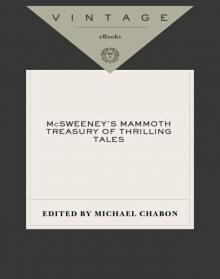 McSweeney's Mammoth Treasury of Thrilling Tales
McSweeney's Mammoth Treasury of Thrilling Tales The Amazing Adventures of Kavalier & Clay
The Amazing Adventures of Kavalier & Clay The Yiddish Policemen's Union
The Yiddish Policemen's Union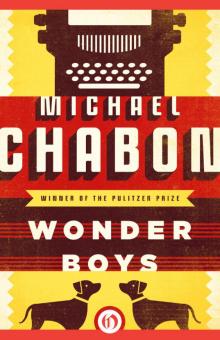 Wonder Boys
Wonder Boys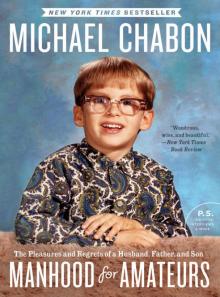 Manhood for Amateurs
Manhood for Amateurs Kingdom of Olives and Ash: Writers Confront the Occupation
Kingdom of Olives and Ash: Writers Confront the Occupation Gentlemen of the Road: A Tale of Adventure
Gentlemen of the Road: A Tale of Adventure A Model World and Other Stories
A Model World and Other Stories Pops: Fatherhood in Pieces
Pops: Fatherhood in Pieces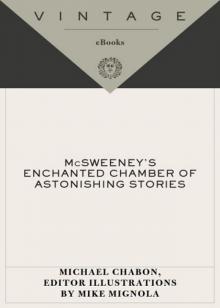 McSweeney's Enchanted Chamber of Astonishing Stories
McSweeney's Enchanted Chamber of Astonishing Stories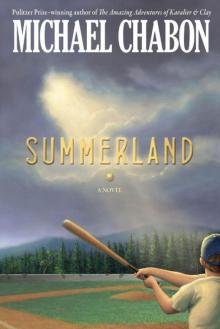 Summerland
Summerland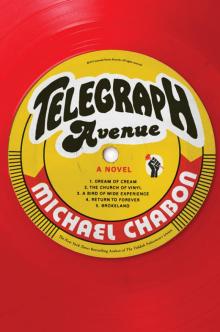 Telegraph Avenue
Telegraph Avenue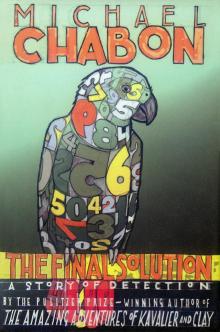 The Final Solution
The Final Solution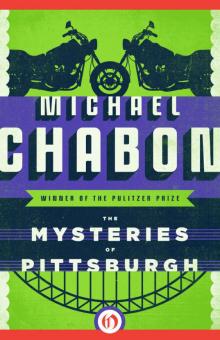 The Mysteries of Pittsburgh
The Mysteries of Pittsburgh Werewolves in Their Youth
Werewolves in Their Youth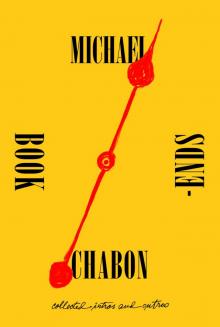 Bookends
Bookends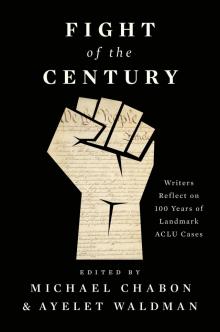 Fight of the Century
Fight of the Century Maps and Legends
Maps and Legends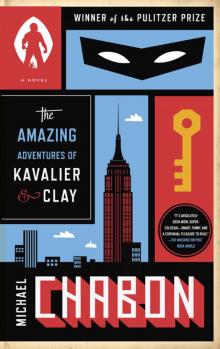 The Amazing Adventures of Kavalier & Clay (with bonus content)
The Amazing Adventures of Kavalier & Clay (with bonus content) Kingdom of Olives and Ash
Kingdom of Olives and Ash Pops
Pops Gentlemen of the Road
Gentlemen of the Road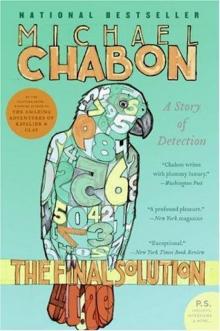 The Final Solution: A Story of Detection
The Final Solution: A Story of Detection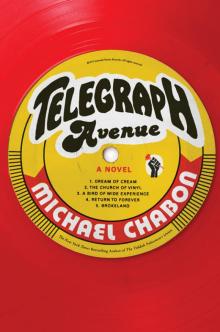 Telegraph Avenue: A Novel
Telegraph Avenue: A Novel